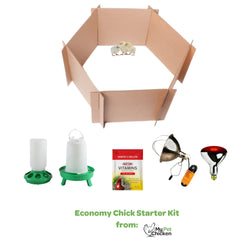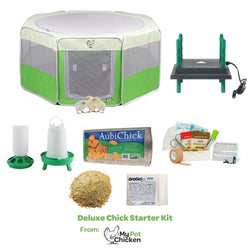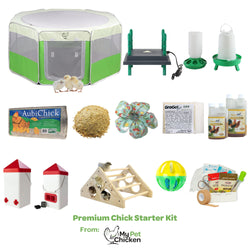How do I handle a flighty chicken?
Back to blog
If the hen you need to handle runs from you every time you get near, what do you do--chase her around the yard and see who gets tired first? Well, you can try. But we don't recommend it. Your chickens can fly out of reach, after all. Then what are you going to do? Plus, there's just a much easier way.

The easiest way to pick up a chicken who doesn't normally allow herself to be picked up is to simply wait until she settles down at night, and pick her up off the roost while she's sleeping. You'll want to gently but firmly place your hands around her, holding her wings to her body in case she wakes. You may have heard it said that chickens go into a sort of trance when they go to roost at night, and that's true. But let us explain the specifics of this "trance," and why it can help you handle your wayward birds, because it's really quite fascinating!
If you see a chicken with one eye open and one closed, your chicken is probably in USWS mode. And your chicken is more likely to be in USWS mode if she is at the end of the roost. The chickens who roost between other birds are more likely rest both halves of their brain at once, while those at the edges may actuallykeep one eye open. The eye they keep open is the one pointing away from the flock. After one side of their brain has slept for a while, they may turn around on the roost so their other eye can keep watch, and they can rest the other half of their brain. Cool and weird, right?
That said, the result is that a chicken who has settled down to roost for the night can usually be handled easily. Keep the lights out, and use just enough light via a flashlight or headlamp for what you need to do.

The easiest way to pick up a chicken who doesn't normally allow herself to be picked up is to simply wait until she settles down at night, and pick her up off the roost while she's sleeping. You'll want to gently but firmly place your hands around her, holding her wings to her body in case she wakes. You may have heard it said that chickens go into a sort of trance when they go to roost at night, and that's true. But let us explain the specifics of this "trance," and why it can help you handle your wayward birds, because it's really quite fascinating!
How chickens sleep
Chickens sleep the same way humans do, for the most part. They even go through REM sleep--meaning they may have dreams like we do--although for chickens this may take just a few seconds at a time. But chickens also have a mode of sleep that humans don't experience. That type of sleep is called unihemispheric slow-wave sleep, or USWS. This is a way of sleeping in which--this is really weird--they will rest just one half of their brains at a time. They quite literally keep one eye open. After all, chickens are prey animals, and since nocturnal predators may be looking for a chicken dinner, they have to remain a bit wary.If you see a chicken with one eye open and one closed, your chicken is probably in USWS mode. And your chicken is more likely to be in USWS mode if she is at the end of the roost. The chickens who roost between other birds are more likely rest both halves of their brain at once, while those at the edges may actuallykeep one eye open. The eye they keep open is the one pointing away from the flock. After one side of their brain has slept for a while, they may turn around on the roost so their other eye can keep watch, and they can rest the other half of their brain. Cool and weird, right?
Why USGS helps your sleeping chickens
At first blush, it would seem like being able to handle a creature that literally keeps one eye open for danger, even when sleeping, would be MORE difficult, not LESS. However, the response of a "half-sleeping" chicken who sees a predator is often what ethologists refer to as "tonic immobility." In other words, they remain unmoving and "play dead." This "trance" reaction doesn't make a whole lot of sense, intuitively, but since most predators only hunt living prey, this semi-paralysis can at times be a successful defense mechanism. Other times, of course, not-so-much. Raccoons in particular DO eat carrion when food is scarce, so playing dead will not always help your flock out if your coop is invaded at night by a raccoon. (That said, carrion is not the first choice of food for a raccoon, so some raccoons can first be drawn to eat the chicken feed in your feeders or eggs they find in nests.)That said, the result is that a chicken who has settled down to roost for the night can usually be handled easily. Keep the lights out, and use just enough light via a flashlight or headlamp for what you need to do.











